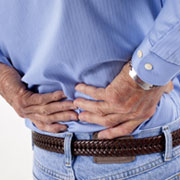LEARN ABOUT THE DYNAMICS OF APPLIED BIOMECHANICSAND AND UNDERSTAND YOUR PAIN:
We now have a deeper understanding of how the low back gets injured and degenerates. Shearing forces in the lumbar spine compromise its stability. With this knowledge, our evaluations are more comprehensive, and treatment plans for low back pain and radiculitis are more specialized. There is also greater awareness of how psychological, social, and biomechanical factors influence pain. The impact of biomechanical and fascial relationships has been well documented and is an integral part of our pain evaluation process.

LEARN HOW OUR OFFICE CAN HELP YOUR INJURY THROUGH THE DYNAMICS OF APPLIED BIOMECHANICS:
A thorough low back exam includes a complete assessment of the biomechanics of the lower quadrant, as well as an evaluation of the lumbar spine, pelvis, glutes, and trunk. It’s also crucial to understand lower cross syndrome and its impact on low back pain due to biomechanical dysfunction. Most acute low back pain is caused by muscle spasms or sacroiliac joint dysfunction, often triggered by specific incidents or factors. These issues typically arise on top of a biomechanically vulnerable body with muscular weaknesses and imbalances in the lower trunk, pelvis, and legs.
Most instances of low back pain are caused by muscle spasms resulting from muscle imbalances and biomechanical dysfunction. However, more significant radicular symptoms and MRI findings may also be present. Dallmeyer’s treatment plans take a comprehensive approach to address all of these concerns.
However, underlying MRI and x-ray findings of the lumbar spine, such as degenerative disc disease, osteoarthritis, facet syndrome, spondylosis, spondylitis, and spondylolisthesis, may also be present. These conditions are often symptomatic due to significant shearing forces in the lumbar spine, resulting from pelvic weakness, lower extremity imbalances, and daily biomechanical dysfunction. In such cases, surgery and/or anti-inflammatory injections may be necessary. We frequently collaborate with pain specialists and work with patients who are receiving injections or have undergone surgery, helping them restore movement, stability, and strength.
The treatment philosophy we use at Dallmeyer Physical Therapy is rooted in the biomechanical and dynamic research of Stuart McGill (http://www.backfitpro.com) and Dr. Chris Powers. In addition to this, we integrate principles of movement function restoration from the teachings of Vladimir Janda, MD, DSC, who emphasizes movement retraining, patterning, and overall proprioceptive facilitation.
For patients presenting with radiculitis, we assess them using the McKenzie Method (also known as MDT – Mechanical Diagnosis and Therapy), which incorporates movement as a treatment. Patients are taught a series of self-treatment strategies that have been proven to provide long-lasting relief from back pain.
We also specialize in hands-on techniques for myofascial restoration and postural integration, aiming to restore proper balance in the lower quadrant. This hands-on approach is rooted in the teachings of Ida Rolf, who emphasized the pelvis as the keystone of the body and its relationship to the lower extremities and hips. Renowned clinician, lecturer, and author Thomas Myers has effectively demonstrated the significant impact of the fascial system on symptoms. His anatomical work has provided an additional tool to enhance the Rolfing approach.
Although pain control through injections is widely used today, our rehabilitative approach can complement other pain relief techniques. Many individuals can resolve their low back pain and restore function through progressive, non-painful physical rehabilitation. Treatment plans typically begin with myofascial release and postural integration, focusing on the mechanisms of pain and empowering the patient to control their pain levels. From there, we progress to restoring proper movement patterns and implementing strengthening techniques.
At our clinic, we frequently use the Med-X machine for back strengthening. This machine isolates and helps restore strength to the multifidus and the thoracic and lumbar longissimus muscle groups of the lumbar spine. These key muscles play a critical role in stabilizing the lumbar spine and reducing shearing forces.
Low back pain, while often debilitating, is treatable as described above. Pain from a degenerated lumbar spine and/or hip can be overwhelming, but it can be managed. Degeneration of the spine typically indicates increased shearing forces and physical stress. However, with a targeted treatment plan, we can modify movement patterns and reduce negative forces on the spine, ultimately promoting healing and alleviating pain.
LEARN HOW YOU CAN PREVENT FUTURE INJURIES:
By understanding how the low back is injured through destructive shearing forces and pelvic/lumbar spine instabilities, we can also provide strategies to prevent future incidents. Key focus areas include flexibility, muscle balance, functional movements, and proper lifting techniques. Through education, exercise, and hands-on treatment, we equip our patients with the tools they need to restore function and prevent further issues. By recognizing individual movement patterns and maintaining stability in the lumbar spine—strengthening the trunk, abdomen, and glutes—patients can protect their lumbar spine and prevent ongoing shearing forces or further deterioration.
